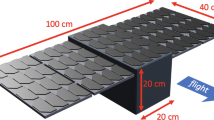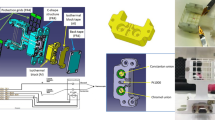Abstract
The structure of the upper atmosphere of Mars (above ∼100 km) has been probed in situ mainly using spacecraft accelerometers during the aerobraking phases of 3 Mars orbiters. In a similar manner, the Mars Atmosphere and Volatile Evolution (MAVEN) Accelerometer Experiment (ACC) will also use atmospheric drag accelerations sensed by inertial measurement units (IMU) onboard the spacecraft to recover atmospheric density along the orbiter path. These densities are used to estimate hydrostatic ‘vertical’ density and temperature profiles, along track and altitudinal density waves, and latitudinal and longitudinal density variations. The IMU accelerometer signal-to-noise should permit profile reconstructions from spacecraft periapsis, nominally at 150 km altitude, to ∼170 km, an altitude range nominally spanning densities of 0.05–0.15 kg/km3. However, in situ measurements over a much greater altitude range, down to ∼125 km (reaching densities of ∼2–3.5 kg/km3), can be made during each of five week-long “Deep Dip” (DD) campaigns, and these are the prime focus of the Accelerometer Experiment. Judicious choice of the timing of these Deep-Dip campaigns during the MAVEN periapsis progression through local time, latitude and longitude in both hemispheres and in different seasons will add significantly to the existing data base of lower thermospheric densities. Other IMU and attitude control data may be used to estimate torques in order to improve the atmospheric density analysis, especially in the higher altitudes of the nominal science orbit, and, more challengingly, to estimate cross-track winds during the Deep-Dips.











Similar content being viewed by others
References
D.T. Baird, R. Tolson, S.W. Bougher, B. Steers, Zonal wind calculations from Mars Global Surveyor Accelerometer and rate data. J. Spacecr. Rockets 44, 1180–1187 (2007)
S.W. Bougher, Final report: JPL/CDP MAVEN project: coupled MGCM-MTGCM Mars thermosphere simulations and resulting data products in support of the MAVEN Mission. August 16 (2012)
S.W. Bougher, J.M. Bell, J.R. Murphy et al., Polar warming in the Mars thermosphere: seasonal variations owing to changing insolation and dust distributions. Geophys. Res. Lett. 33, L02203 (2006). doi:10.1029/2005GL024059
S.W. Bougher, P.-L. Blelly, M. Combi et al., Neutral upper atmosphere and ionosphere modeling. Space Sci. Rev. 139, 107–141 (2008). doi:10.1007/s11214-008-9401-9
D. Fritts, L. Wang, R. Tolson, Mean and gravity wave structures and variability in the Mars upper atmosphere inferred from Mars Global Surveyor and Mars Odyssey aerobraking densities. J. Geophys. Res. (2006). doi:10.1029/2006JA011897
J. Forbes, A. Bridger, S. Bougher, M.Hagan.J. Hollingsworth, G. Keating, J. Murphy, Nonmigrating tides in the thermosphere of Mars. J. Geophys. Res. (2002). doi:10.1029/2001JE001582
G.M. Keating, S.W. Bougher, R.W. Zurek et al., The structure of the upper atmosphere of Mars: in-situ accelerometer measurements from the Mars Global Surveyor. Science 279, 1672–1676 (1998)
G.M. Keating, M. Theriot, R. Tolson et al., Brief review on the results obtained with the MGS and Mars Odyssey 2001 accelerometer experiments, in Mars Atmosphere: Modeling and Observations Workshop, Granada, Spain (2003)
B. Jakosky et al., The Mars Atmosphere and Volatile Evolution (MAVEN) Mission (2014, this issue)
P. Mahaffy et al., The neutral gas and ion mass spectrometer on the MAVEN Mission (2014, this issue)
W. McClintock et al., The imaging ultraviolet spectrograph for the MAVEN Mission (2014, this issue)
M. Smith, Interannual variability in TES atmospheric observations of Mars during 1999–2003. Icarus 167, 148–165 (2004)
R. Tolson, G. Keating, R. Zurek, S. Bougher, C. Justus, S. Fritts, Application of accelerometer data to atmospheric modeling during Mars aerobraking operations. J. Spacecr. Rockets (2007). doi:10.2514/1.28472
R. Tolson, E. Bemis, S. Hough, K. Zaleski, G. Keating, J. Shidner, S. Brown, A. Brickler, M. Scher, P. Thomas, Atmospheric modeling using accelerometer data during Mars Reconnaissance Orbiter aerobraking operations. J. Spacecr. Rockets (2008). doi:10.2514/1.34301
Acknowledgement
This work was sponsored by NASA, including a part under contract through the Jet Propulsion Laboratory, California Institute of Technology.
Author information
Authors and Affiliations
Corresponding author
Rights and permissions
About this article
Cite this article
Zurek, R.W., Tolson, R.H., Baird, D. et al. Application of MAVEN Accelerometer and Attitude Control Data to Mars Atmospheric Characterization. Space Sci Rev 195, 303–317 (2015). https://doi.org/10.1007/s11214-014-0095-x
Received:
Accepted:
Published:
Issue Date:
DOI: https://doi.org/10.1007/s11214-014-0095-x




